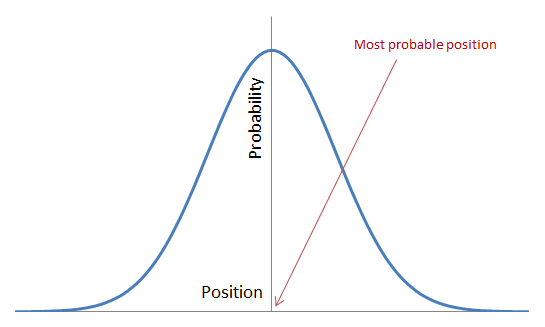One of the unique and most innovative aspects of quantum mechanics is the concept that the state of any subatomic particle cannot be known before it is measured. For instance, before we measure the position of the particle, it can be in any of many possible positions. There is a certain probability that the particle will be in any of these positions.
The probability of the particle being in any of these possible positions is described by what is known as the “wave function.” This is shown in the graph below:

The particle may be on any point on the x-axis. Each point has a particular probability shown by the blue curve. For instance, the point at which the x-axis and y-axis meet, which the red arrow points to, has the highest probability.
Before we use an instrument to detect the particle, we cannot tell where it may be. It is more likely to be in certain positions than others, but we cannot be sure where it might exactly be in a particular point in time. Put differently, the particle spends different amounts of time at all possible locations, but we do not know where it is before we measure its position.
When we measure the position of the particle, its wave function is said to “collapse,” resulting in one specific value. Now we know exactly where the particle is. The wave function represents the behaviour of the particle as a wave, but when its wave function collapses at the point of measurement the particle behaves, well, as a particle. This is the dual nature of the subatomic particle as both wave and particle.
The mainstream interpretation of quantum mechanics considers this probabilistic, indeterministic nature and the impossible separation of the observer from the observed as intrinsic characteristics of the subatomic world. This interpretation was put forward by Neils Bohr and Werner Heisenberg during their collaboration in the late twenties of the twentieth century in Copenhagen, which is why it is known as the “Copenhagen interpretation.” It remains by far the most popular interpretation of quantum mechanics.
The Copenhagen interpretation could not have been more revolutionary. It removed common sense certainty, determinism, and causality from the micro world and changed the very meaning of reality. One famous quote that articulates this fact is Heisenberg’s “reality is in the observations, not in the electron.”
This radical interpretation was challenged from the beginning by alternatives known as “hidden variable” theories. A hidden variable interpretation states that the indeterminacy in quantum mechanics is due to the incompleteness of this scientific knowledge. There are variables that the current theory does not consider which is why the subatomic world looks probabilistic and nondeterministic. One famous advocate of a hidden variable interpretation of quantum mechanics was Altbert Enistein who famously said “God does not play dice.” The most famous hidden variable theory is the “causal” interpretation” of David Bohm.
There are two aspects of the Copenhagen interpretation of quantum mechanics that have particularly profound philosophical and epistemological implications. First, over the centuries people attributed any uncertainty about the world to their ignorance or the incompleteness of their knowledge. This applied to scientists also who always presumed that there was something they did not know whenever they could not explain a phenomenon fully or accurately. The Copenhagen interpretation is the first time in history that scientists have projected the incompleteness of knowledge of man onto the world itself, presenting this incomplete knowledge, or indeed ignorance, as complete knowledge. The standard interpretation of quantum mechanics presumes that we have discovered all the objects, properties, and laws that describe the behaviour of the components of the subatomic world, so the limited accuracy with which we can describe that world reflects inaccuracy intrinsic to the world itself, and our inability to predict its behaviour is due to its being inherently unpredictable.
Hidden variable interpretations, on the other hand, follow the fundamental methodology that scientists, and people in general, always used when exploring the world. When they could not describe or predict a phenomenon accurately, they would conclude that their knowledge was incomplete or that some aspects of their theory might be wrong. They would never try to project that limited ability onto the world itself. The Copenhagen interpretation dealt with this change in methodology by claiming that the micro world has its own laws which are very different from those that govern the macro world. One problem is that this is just an outcome of the theory not an independent proof of it. Another is that there is no actual separation between the micro and macro worlds. Every macro object consists of micro particles. This artificial disconnect between the micro and macro worlds remains an unsolved problem for physicists who have two completely different sets of laws that describe what is effectively one world.
Second, in some way, the Copenhagen interpretation made the micro world partly a product of the human activity of observation. This world is not defined completely until it is observed. What is amazing about this position is that it takes one product of this world, man, and makes him in some way its creator! Of course, man affects the world as he interacts with it, but the same science accepts that the world existed well before man. Whatever laws govern the micro, macro, or both worlds today must have been there before man existed. The fact that when we observe the micro world we disturb it and cause changes to its state does not mean that it did not have a state that could be described fully and accurately before we changed it. We just did not know it.
There is one final criticism of the Copenhagen interpretation of quantum mechanics that applies to how other scientific theories are viewed. Science is a social activity that creates models or constructs to explain natural and other phenomena. Science cannot be other than a form of constructivism. Science cannot be claimed to represent pure realism. Science produces theories that are in a continuous state of change and development. This is a process of developing constructs to understand the real world. This is not the same as discovering what the world really is. This is not to deny that science has discovered a huge amount of real facts about the world, but facts alone could never make up science. In both the micro and macro worlds, when studying matter and living organisms, science combines facts with man-made constructs to produce theories and hypotheses to give a working explanation of the world.
Copyright © 2013 Louay Fatoohi
Blog: https://www.louayfatoohi.com
![]() http://www.facebook.com/LouayFatoohiAuthor
http://www.facebook.com/LouayFatoohiAuthor
![]() http://twitter.com/louayfatoohi
http://twitter.com/louayfatoohi
![]() http://www.instagram.com/Louayfatoohi
http://www.instagram.com/Louayfatoohi
Website: http://www.quranicstudies.com
All Rights Reserved.


5 thoughts on “Presenting Ignorance as Knowledge: The Standard Interpretation of Quantum Mechanics”
Another important fact to bear in mind is that Western Science relies on experimentation to prove its theories. So what science cannot experiment with it cannot accept so easily. This has been one of the main sticking points between science and theology. Science needs lots of proof to convince its audience and theology requires its followers to have faith only. The scientific world has now proven quite a lot of what the Qur’an had claimed 1500 years ago but still it appears that it is not enough to convince all the people of science. This is probably because the people of science are looking for a more in-depth explanation rather than just textual statements of the Qur’an.
You are right that experimentation is one of the most prominent features of science. But while experiments and observations were always basic building blocks in science, there were never the only constituents of scientific knowledge. Theories, by definition, introduce elements that are not experimental data or observations. These constructs that are needed to put all experimental data and observations in a coherent conceptual model that is meant to only explain the known phenomena, but also predict yet unconfirmed ones. In the case of quantum mechanics, the introduction of such constructs led to the standard interpretation, showing a subatomic world that behaves in a completely different way from the macro world. Hidden variable theories effectively claim that the Copenhagen interpretation replaces the missing information about and from those hidden variables with theoretical, unjustified concepts.
Scientific knowledge is precious and tries to be objective, but its objectivity and ability to be objective have always been oversold. Dogma has always had its place in science. The prevailing scientific paradigm, as historian and philosopher of science Thomas Kuhn called it, at any time has a great deal of assumptions that are imposed on the empirical data. Science is a social enterprise that cannot escape the limits of its creator: man.
Nice article. Sensible thinking on this topic. When i studied this topic and in my later reflections on the methods and philosophy of science I have had similar thoughts to what you describe.
Science is now a new clergy class and they must always have an answer or else an answer why they cant (yet) have an answer. Observation of galactic rotation not fitting in with equations of motion, its dark matter!
Dark energy, probabalistic wave function and so on. This is the same in biology where the fairy tale of evolutionary theory is filled with stories and excuses masquerading as knowledge.
Filling gaps with terminology in place of recognised ignorance.
Ah! You haven’t said anything about Copenhagen Interpretation.
I came here a few years ago but could not understand this article. Now I found it again. I’m happy we had one of your books else I forgot your name!
This is likely going to blow up in the future. We better study it now and think about it.
I am ready to accept god without any proof. But it’s also nice to have an explanation that makes sense.
Unfortunately, Copenhagen destroys completely Imam al-Ghazali his argument that everything must have a cause. Because everything we know has a cause.
Until then,
Follow-up to my previous comment:
When the piece of light is about to pass through the filter, some pass, some not.
Since all pieces of light is equal, what ’causes’ a piece to become pass-able and others not pass-able?
You know, what ’causes’ a piece to pass, does not have to be predictable. God’s action does not need be predictable.
It took me long enough to realise, the Classical Paradigm, is itself against Free Will. If all my actions are determined by how molecules move in my head, as if since the Beginning of the universe all actions had been pre-determined by the so-called God-put Laws, it means that life is a theatrical play. Of which once it has started, no character has control over how the theatre will unfold.
But of course that is not true. Because according to the Quantum Paradigm, the fate of a particle has not been sealed until He, Decrees.
Perhaps also, if we are one big particle, our fate is not sealed either, until He Decrees.
To which we ask, oh does God decide Heaven or Hell to us—as it does a particle? Whatever the answer, that just shifts the debate to the good old Predestination vs. Free Will, averting the Physics vs. Free Will.
I misunderstood the title the first time—thinking Quantum Theory opposed religion. A trivial title, but yeah, a lesson for us all. Don’t say you know when you don’t!